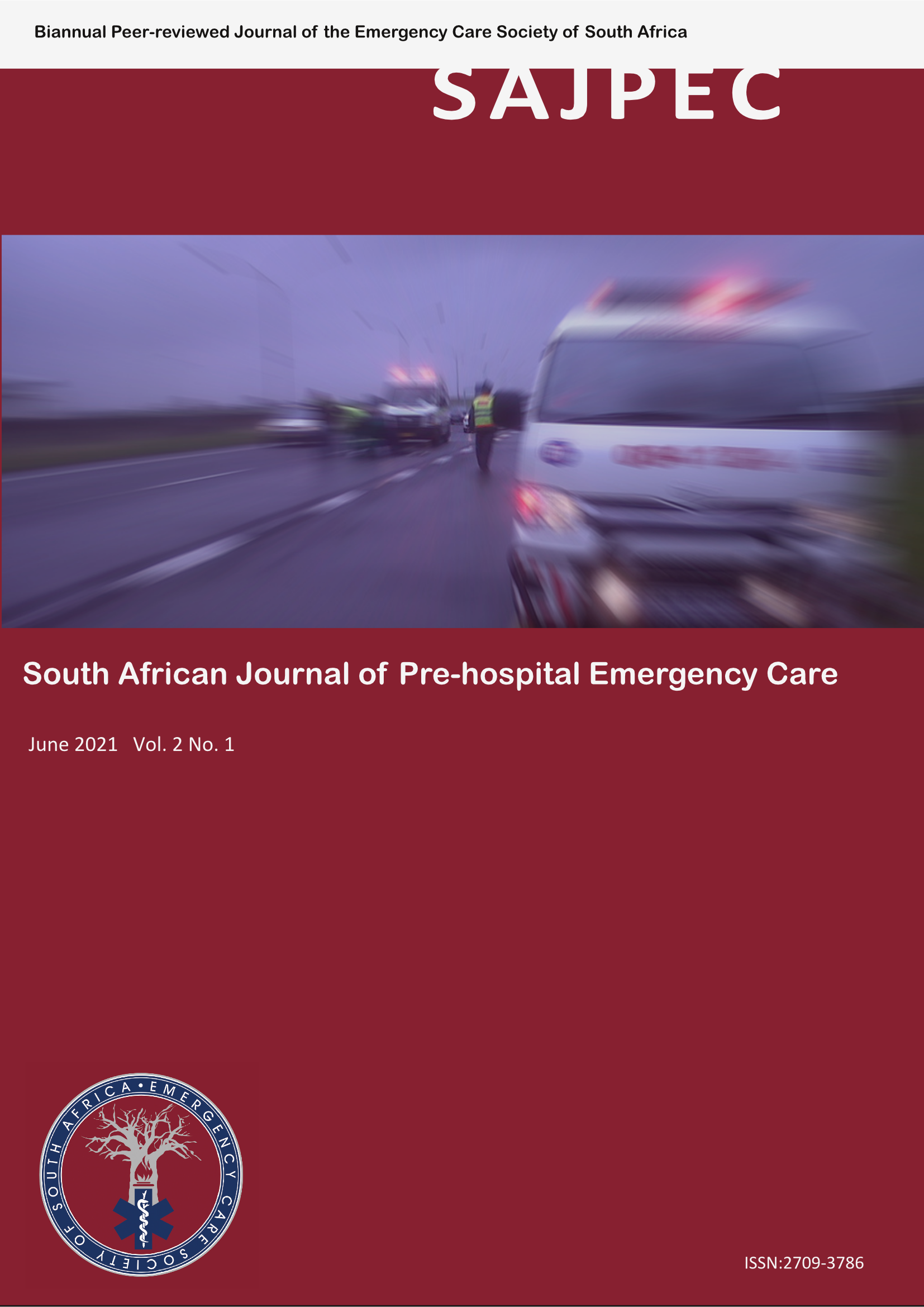Extent of post-traumatic stress disorder among Eastern Cape emergency care workers in the public health care sector
Abstract
Background: Pre-hospital emergency care workers (PECWs) often struggle to cope with an increasingly hostile environment while on duty. As a result, the prevalence of post-traumatic stress disorder (PTSD) amongst PECWs is on the rise and negatively affects their ability to treat patients. Further, PTSD could cloud PECWs’ clinical decision-making and judgement. This ultimately places strain on emergency care departments’ resources and directly affects patient care and service delivery. The aim of the study was to determine the extent to which PECWs experience PTSD symptoms in Nelson Mandela Bay (NMB).
Methods: A quantitative design and convenience sampling method were used. The research population for this study was all operational PECWs employed by the Eastern Cape Department of Health within the emergency medical services (EMS) in NMB. Data were collected by means of a self-administered questionnaire comprising two sections; the first section focused on respondents’ demographic information, and the second section was a validated PTSD questionnaire. Descriptive and inferential statistics were reviewed using Microsoft Excel.
Results: Sixty-eight PECWs took part in the study. It was identified that of the 68 respondents, 41 (60.3%) showed symptoms of PTSD and could possibly be diagnosed with PTSD. The mean PTSD score was 42.01±17.354, ranging in the category of ‘possible diagnosis of PTSD’. The highest mean PTSD scores were reported among respondents who identified themselves as female (p<0.001). Those within the age category of 51–60 years, those who were Advanced Life Support (ALS) practitioners, and those with 20 years or more work experience also had high mean PTSD scores.
Conclusion: PTSD remains a burden on both the individual and the organisation employing the individual. This study highlighted that many PECWs employed in the Eastern Cape public health care sector showed symptoms and could be diagnosed with PTSD, with female PECWs being at the highest risk.
Downloads
References
Haugen P. Treating posttraumatic stress disorder in first responders: A systematic review. Clin Psychol Rev. 2012 Jul;32(5):370-80. doi: 10.1016/j.cpr.2012.04.001.
Lancaster CL, Teeters JB, Gros DF, Back SE. Posttraumatic Stress Disorder: Overview of Evidence-Based Assessment and Treatment. J Clin Med. 2016; 5(11). pii: E105.
Thibaut F. Anxiety disorders: a review of current literature. Dialogues Clin Neurosci. 2017; 19(2): 87–8.
Berger W, Coutinho ES, Figueira I, Marques-Portella C, Luz MP, Neylan TC, Marmar CR, Mendlowicz MV. Rescuers at risk: a systematic review and meta-regression analysis of the worldwide current prevalence and correlates of PTSD in rescue workers. Soc Psychiatry Psychiatr Epidemiol. 2012;47(6):1001–1011. doi: 10.1007/s00127-011-0408-2.
Minnie L, Goodman S, Wallis L. Exposure to daily trauma: The experiences and coping mechanism of Emergency Medical Personnel. A cross-sectional study’., Afr J Emer Med. 2015;5(1):12–8.
Majeke F. Employee Assistance and Wellness Service, Umvoti Wellness Services. 2015; 0437046444(011):1–5.
Yufik T, Simms LJ. A meta-analytic investigation of the structure of posttraumatic stress disorder symptoms. Journal of Abnormal Psychology [Internet]. 2010 Nov;119(4):764–76.
US Dep of Veteran Affairs. PTSD Checklist for DSM-5 (PCL-5). 2013[Online] Available at: https://www.ptsd.va.gov/professional/assessment/adult-sr/ptsd-checklist.asphttps://www.ptsd.va.gov/professional/assessment/adult-sr/ptsd-checklist.asp [Accessed 22 04 2018].
Stinchfield R, McCready J, Turner NE, Jimenez-Murcia S, Petry NM, Grant J, et al. Reliability, validity, and classification accuracy of the DSM-5 diagnostic criteria for gambling disorder and comparison to DSM-IV. Journal of Gambling Studies [Internet]. 2016 Sep [cited 2020 Jan 15];32(3):905–22. Available from: http://0-search.ebscohost.com.wam.seals.ac.za/login.aspx?direct=true&db=psyh&AN=2016-41207-007&site=ehost-live&scope=site
Stewart J. Swartz L. Post-traumatic stress symptoms in emergency service ambulance personnel. Social Work. 2014;41(4).
Holowka DW, Danny G, Marx BP, Keane TM. PTSD symptoms among male Vietnam Veterans: Prevalence and associations with diagnostic status.2012 Available: https://www.researchgate.net/publication/232518371 [Accessed .15-01-2020].
Vincent-Lambert C, Westwood R. Students’ views on the need for hostile environment awareness training for South African emergency medical care students. African Journal of Health Professions Education [Internet]. 2019 Mar [cited 2020 Jan 15];11(1):12–5. Available from: http://0-search.ebscohost.com.wam.seals.ac.za/login.aspx?direct=true&db=asn&AN=136572584&site=ehost-live&scope=site
Eiche C, Birkholz T, Jobst E, Gall C, Prottengeier J. Well-being and PTSD in German emergency medical services - A nationwide cross-sectional survey. Plos One [Internet]. 2019 Jul 23 [cited 2020 Jan 15];14(7):e0220154. Available from: http://0-search.ebscohost.com.wam.seals.ac.za/login.aspx?direct=true&db=mdc&AN=31335903&site=ehost-live&scope=site
Kerai S, Pasha O, Khan U, Islam M, Asad N, Razzak J. Association of post-traumatic stress disorder and work performance: A survey from an emergency medical service, Karachi, Pakistan. World Journal Of Emergency Medicine [Internet]. 2017 [cited 2020 Jan 15];8(3):214–22. Available from: http://0-search.ebscohost.com.wam.seals.ac.za/login.aspx?direct=true&db=mdc&AN=28680519&site=ehost-live&scope=site
Bensimon M. Elaboration on the association between trauma, PTSD and posttraumatic growth: The role of trait resilience. Personality and Individual Differences [Internet]. 2012 May [cited 2020 Jan 15];52(7):782–7. Available from: http://0-search.ebscohost.com.wam.seals.ac.za/login.aspx?direct=true&db=psyh&AN=2012-06763-006&site=ehost-live&scope=site
Olff M. Sex and gender differences in post-traumatic stress disorder: an update. European Journal of Psychotraumatology. 2017;8(Supp4):1351204.
Pooley AE, Benjamin RC, Sreedhar S, Eagle AL, Robison AJ, Mazei-Robison MS, et al. Sex differences in the traumatic stress response: PTSD symptoms in women recapitulated in female rats. Biology Of Sex Differences [Internet]. 2018 Jul 5 [cited 2020 Jan 15];9(1):31. Available from: http://0-search.ebscohost.com.wam.seals.ac.za/login.aspx?direct=true&db=mdc&AN=29976248&site=ehost-live&scope=site
Iranmanesh S, Tirgari B, Bardsiri HS. Post-traumatic stress disorder among paramedic and hospital emergency personnel in south-east Iran. World Journal Of Emergency Medicine [Internet]. 2013 [cited 2020 Jan 15];4(1):26–31. Available from: http://0-search.ebscohost.com.wam.seals.ac.za/login.aspx?direct=true&db=cmedm&AN=25215089&site=ehost-live&scope=site
Copyright (c) 2021 South African Journal of Pre-Hospital Emergency Care

This work is licensed under a Creative Commons Attribution-NonCommercial-NoDerivatives 4.0 International License.
Authors grant the Emergency Care Society of South Africa the exclusive right to publish, display, reproduce and/or distribute the work in print and electronic format and in any medium known or hereafter developed, including for commercial use. Authors also agree that the Emergency Care Society of South Africa may retain in print or electronic format more than one copy of the work for the purpose of preservation, security and back-up.


